Bar graphs are used to compare different quantities.
To draw a bar graph
- Label the graph with a title.
- Draw and label the vertical and horizontal axis.
- Mark off equal spaces on one of the axis and label it with a scale that best represents the data.
- Draw bars to show the quantities (all bars should have the same width).
- Label each bar.
A bar graph can be drawn either vertically (up and down) or horizontally (left to right).
Examples
1. Draw a vertical bar graph from the data given in the table
In a vertical bar graph, the bars are vertical.
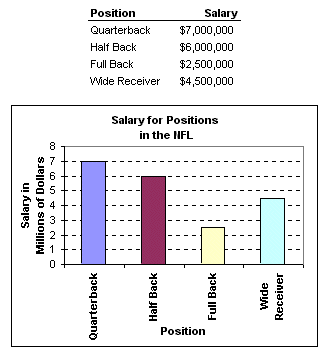
Reasoning
I labeled the bar graph Salary for positions in the NFL.
Since the bars were to run vertically, I labeled the horizontal axis with the positions and the vertical axis with the salary.
To prevent having to write all the zeroes, I chose a scale so that each space is $1,000,000.
Draw bars with lengths equal to the salary.
Label each bar with the appropriate position.
2. Draw a horizontal bar graph from the data given in the table
In a horizontal bar graph, the bars are horizontal.
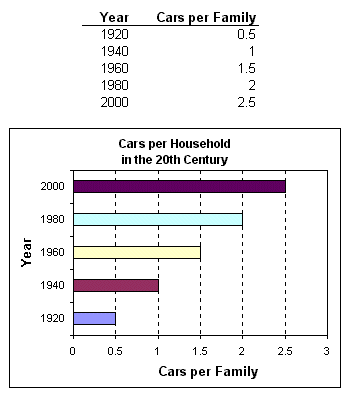
Reasoning
I labeled the graph Cars per Household in the 20th Century.
Since the bars were to run horizontally, I labeled the horizontal axis with the cars per family and the vertical axis with the year.
To make the graph bigger, I let each two spaces equal .5.
Draw bars with a length equal to the number of cars per family.
Label each bar with the appropriate year.
3. Make a data table for the following bar graph
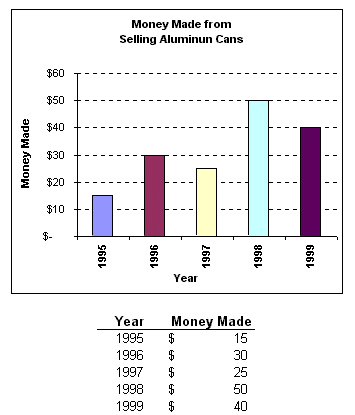
Reasoning
Each space is worth $10.
For each year, determine how long each bar is.
For 1995 and 1997, the bars stop halfway between the two spaces for a reading of $15 and $25.
For 1996, 1998 and 1999, the bars stop on a space for $30, $50 and $40.
In your table, pair the year with the money made.
4. Answer the following questions by reading the bar graph.
Question
Reasoning
A. What was the population of Barville in 1920?
Answer: 500
Look at the length of the bar in 1920.
B. In what year did Barville have a population of 850?
Answer: 1980
C. Find the year where the bar has a length of 850. Between what two years did Barville experience its greatest increase in population?
Answer: Between 1920 and 1930
Find where the biggest increase in the length of the bars is, by counting spaces.
D. Between what two years did Barville experience its greatest decrease in population?
Answer: Between 1960 and 1970
Find where the biggest decrease in the length of the bars is by counting the spaces.
By how much did the population of Barville increase between 1910 and 1950?
Answer: 1500 - 400 = 1100
Take the length of the bar in 1950 and subtract the length of the bar in 1910.
Try these exercises
Use the space provided for each question to write your answers.
1. |
Draw a vertical bar graph from the given data.
Hint: Start your graph by labeling the first temperature 40 ° F. |
Average Temperature
42 ° F
47 ° F
52 ° F
57 ° F |
Month
January
February
March
April |
2. |
Draw a horizontal bar graph from the given data.
Hint: Start your graph by labeling the first space 5 years. |
Year
1920
1940
1960
1980
2000 |
Number of Years of Education
8
10
12
14
16 |
3. Make a table from the following bar graph. Explain your reasoning.

4. Answer the questions using the bar graph provided.
- Which student has the highest GPA?
What is their GPA?
- Which student has the lowest GPA?
What is their GPA?
- How much higher is Junior's GPA than Spot's?
- Which two GPAs could you add together to get Dick's GPA?
Explain your answer.
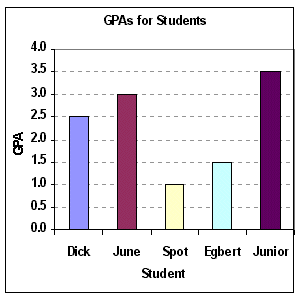
Answers to Practice Problems.

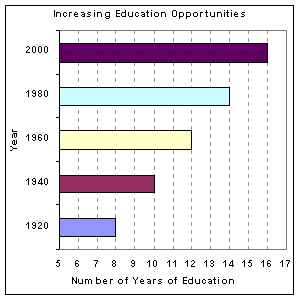
Year
1900
1920
1940
1960
1980
2000 |
Bushel per Acre of Wheat
35
40
45
55
60
70 |
A. |
Junior
3.5 |
Junior's bar is 3.5 GPA units long |
B. |
Spot
1.0 |
Spot's bar is 1.0 GPA units long |
C. |
3.5 - 1.0 = 2.5
|
Subtract Spot's GPA (1.0) from Junior's GPA (3.5) to get 2.5 |
D. |
Spot + Egbert = Dick
1.0 + 1.5 = 2.5 |
If we add Spot's GPA (1.0) to Egbert's GPA (1.5), we get Dick's GPA (2.5) |